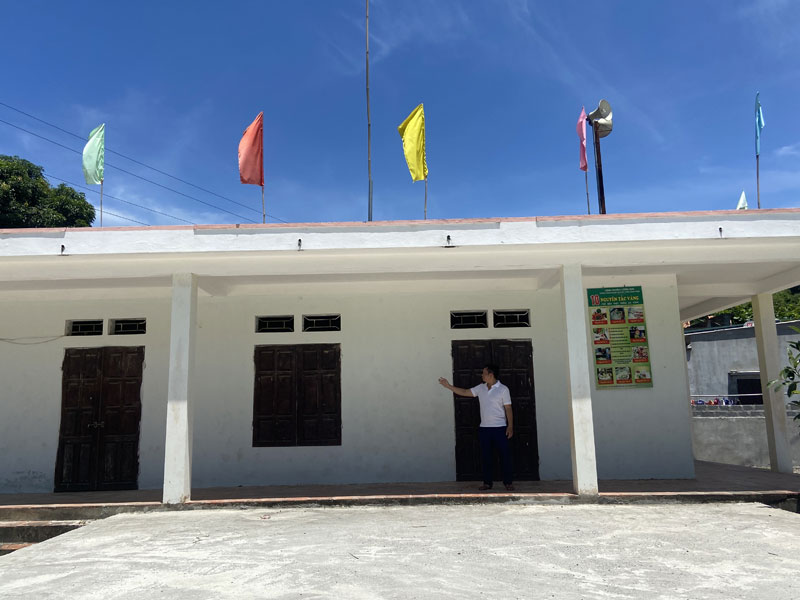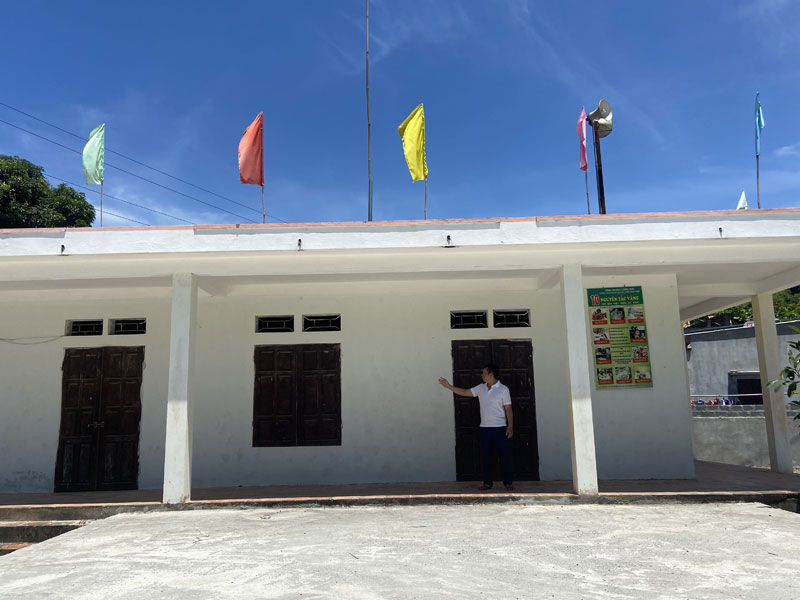
(HBO) - Arriving at Doi area in Ba Hang Doi town (Lac Thuy), we feel the spread of the movement to build model new rural areas. Doi area is now like a modern neighborhood. The houses and the gateways are spacious and clean with trees and flowers blooming from the beginning to the end of the village. The green model gardens have been creating the face of a rich, peaceful and worth living countryside.

From the supported capital, the cultural house of Rong Can
village in Lam Son commune (Luong Son) has been built and put into operation,
well serving the collective activities of the local people.
Mr. Nguyen Van Bong, the Head of Doi
Residential Area, says: When the district launched the movement to build the
new model rural residential area, the regional government quickly propagated
and mobilized people to participate and we received an enthusiastic response.
From the end of 2018, with the local support and the mobilized fund of over 500
million VND from the households in the area, the local people have contributed
their labor to embellish the houses and the alleys, and to improve the
facilities. Many kinds of trees, flowers, shade trees have been planted on both
sides of the road. The local people clean the village roads, the alleys, the
cultural houses, clear the fences, trees, and prun flowers along the roadside
once every month.
After nearly 2 years of implementation, the
face of the new rural areas, the material and spiritual life of the local
people in Doi area has been increasingly raised. With the successful completion
of the criteria, Doi residential area has been awarded A prize in the contest
"the new model rural residential area, the model garden in the period of
2018-2020” organized by Lac Thuy district.
In the other localities of the province, the
movement to build the new model rural residential area is also excitingly
taking place. Rong Can Residential Area in Lam Son commune is one of the
prominent new model rural residential areas of Luong Son district, which was
recognized as the new model rural residential area in 2019. Coming to Rong Vong
in these days, you can not only see the perennial fruit gardens which are close
to the harvest, the straight concrete road cool with the green trees, but you
can also feel the innovative and dynamic atmosphere of the civilized village
that has been constantly developing.
Mr. Le Xuan Cuong, the Vice Chairman of
perennial the People's Committee of Lam Son commune says: Thanks to the
solidarity and efforts of the officials, the party members and the local
people, Rong Can Residential Area has positively changed. The income and the
living standard of the people have increasingly improved. Under the direction
of the district, the communes and the appropriate authorities, the local people
have united and made efforts to implement the criteria of building a
residential area according to the standards of a model new rural residential
area. The community works such as the cultural houses, the sports grounds ...
have been mobilized resources to build and have been put into use, serving the
needs of collective activities of the local people and children.
With an increasingly vibrant and widespread emulation movement aimed at building cultured residential areas and cultured families, Yen Thuy District has been making steady progress toward improving both the material and spiritual well-being of its people, while fostering a civilized, prosperous, beautiful, and progressive community.
Once lacking recreational spaces and community facilities, Residential Group 2 in Quynh Lam Ward (Hoa Binh City) has recently received attention for the construction of a new, spacious, and fully equipped cultural house. The project followed the model of state support combined with public contributions in both labor and funding.
The "All people unite to build cultural life" movement, which has been effectively integrated with Kim Boi district’s socio-economic development goals, is fostering a lively spirit of emulation across local residential areas, hamlets, villages, public agencies, and enterprises. In addition, through the initiative, traditional cultural values are being preserved and promoted, while community solidarity and mutual support in poverty reduction and economic development are being strengthened.
A working delegation of the Hoa Binh provincial People’s Committee led by its Permanent Vice Chairman Nguyen Van Toan on June 11 inspected the progress of a project to build the Mo Muong Cultural Heritage Conservation Space linked to tourism services in Hop Phong commune, Cao Phong district.
Born and growing in the heroic land of Muong Dong, Dinh Thi Kieu Dung, a resident in Bo town of Kim Boi district, in her childhood was nurtured by the sweet lullabies of her grandmother and mother. These melodies deeply imprinted on her soul, becoming an inseparable part of her love for her ethnic group's culture. For over 20 years, this love for her hometown has driven Dung to research, collect, and pass down the cultural values of the Muong people to future generations.
In the final days of May, the Ethnic Art Troupe of Hoa Binh Province organized performances to serve the people in remote, mountainous, and particularly disadvantaged areas within the province. These were not just ordinary artistic shows, but they were the meaningful journeys aimed at spreading cultural values, enhancing the spiritual life of the people and contributing to the preservation of ethnic minority cultural identities.



